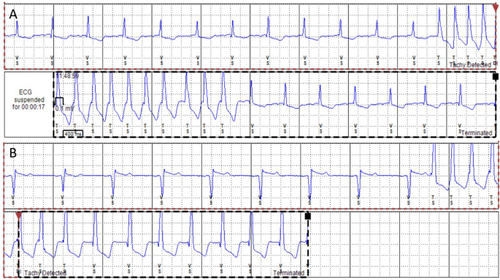Current Cardiology Reports ( IF 3.7 ) Pub Date : 2024-04-12 , DOI: 10.1007/s11886-024-02053-2 Ashwin Roy , Max J. Cumberland , Christopher O’Shea , Andrew Holmes , Manish Kalla , Katja Gehmlich , Tarekegn Geberhiwot , Richard P. Steeds

|
Purpose of Review
Fabry Disease (FD) is a rare lysosomal storage disorder characterised by multiorgan accumulation of glycosphingolipid due to deficiency in the enzyme α-galactosidase A. Cardiac sphingolipid accumulation triggers various types of arrhythmias, predominantly ventricular arrhythmia, bradyarrhythmia, and atrial fibrillation. Arrhythmia is likely the primary contributor to FD mortality with sudden cardiac death, the most frequent cardiac mode of death. Traditionally FD was seen as a storage cardiomyopathy triggering left ventricular hypertrophy, diastolic dysfunction, and ultimately, systolic dysfunction in advanced disease. The purpose of this review is to outline the current evidence exploring novel mechanisms underlying the arrhythmia substrate.
Recent Findings
There is growing evidence that FD cardiomyopathy is a primary arrhythmic disease with each stage of cardiomyopathy (accumulation, hypertrophy, inflammation, and fibrosis) contributing to the arrhythmia substrate via various intracellular, extracellular, and environmental mechanisms. It is therefore important to understand how these mechanisms contribute to an individual’s risk of arrhythmia in FD.
Summary
In this review, we outline the epidemiology of arrhythmia, pathophysiology of arrhythmogenesis, risk stratification, and cardiac therapy in FD. We explore how advances in conventional cardiac investigations performed in FD patients including 12-lead electrocardiography, transthoracic echocardiography, and cardiac magnetic resonance imaging have enabled early detection of pro-arrhythmic substrate. This has allowed for appropriate risk stratification of FD patients. This paves the way for future work exploring the development of therapeutic initiatives and risk prediction models to reduce the burden of arrhythmia.
中文翻译:

法布里病的心律失常发生
审查目的
法布里病 (FD) 是一种罕见的溶酶体贮积症,其特征是由于 α-半乳糖苷酶 A 酶缺乏而导致鞘糖脂在多器官积聚。心脏鞘脂积聚会引发各种类型的心律失常,主要是室性心律失常、缓慢性心律失常和心房颤动。心律失常可能是 FD 死亡的主要原因,而心源性猝死是最常见的心脏死亡方式。传统上,FD 被视为一种储存性心肌病,在晚期疾病中会引发左心室肥厚、舒张功能障碍,并最终导致收缩功能障碍。本综述的目的是概述当前探索心律失常基础新机制的证据。
最近的发现
越来越多的证据表明,FD 心肌病是一种原发性心律失常疾病,心肌病的各个阶段(蓄积、肥大、炎症和纤维化)通过各种细胞内、细胞外和环境机制导致心律失常。因此,了解这些机制如何导致 FD 患者出现心律失常的风险非常重要。
概括
在这篇综述中,我们概述了心律失常的流行病学、心律失常发生的病理生理学、风险分层和 FD 的心脏治疗。我们探讨了在 FD 患者中进行的传统心脏检查(包括 12 导联心电图、经胸超声心动图和心脏磁共振成像)的进步如何能够早期检测致心律失常基质。这使得对 FD 患者进行适当的风险分层成为可能。这为未来探索开发治疗方案和风险预测模型以减轻心律失常负担的工作铺平了道路。



























 京公网安备 11010802027423号
京公网安备 11010802027423号